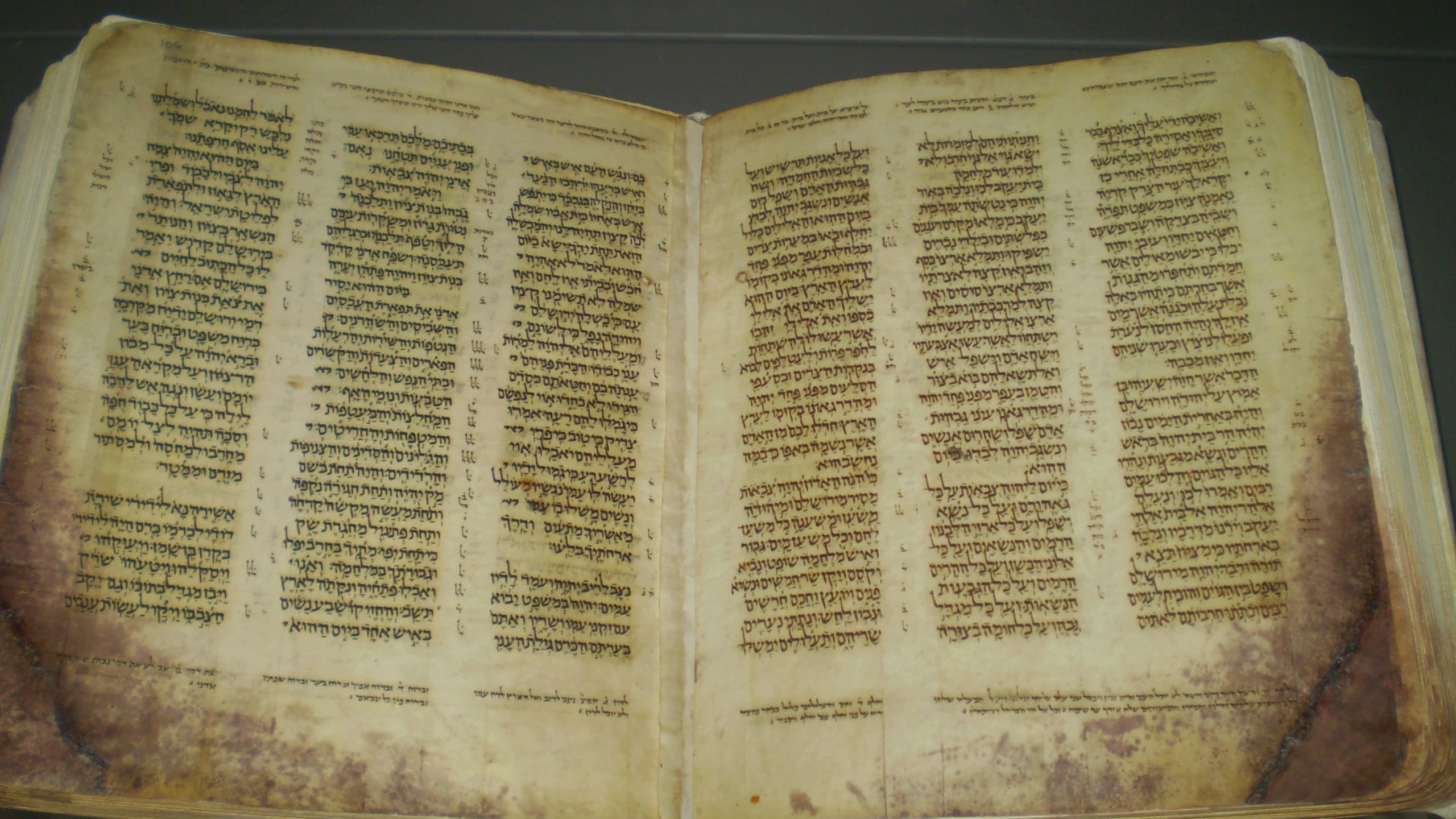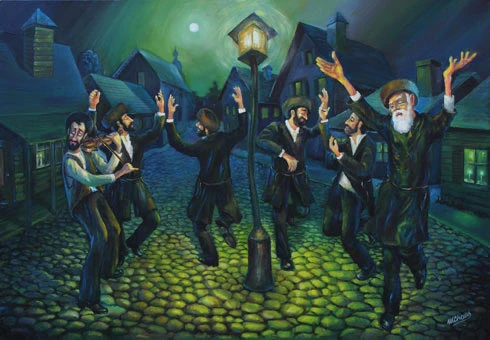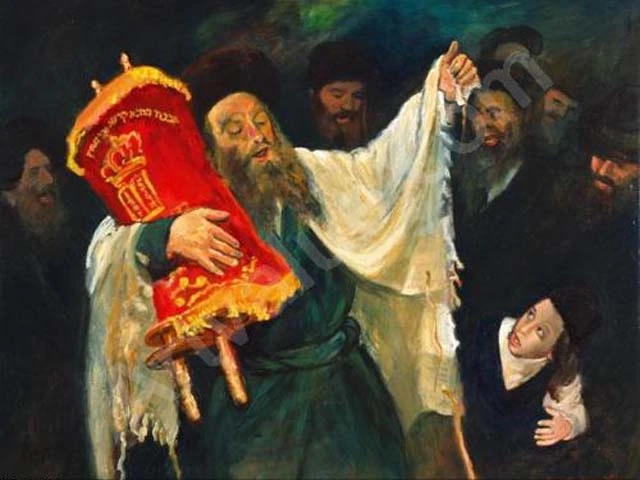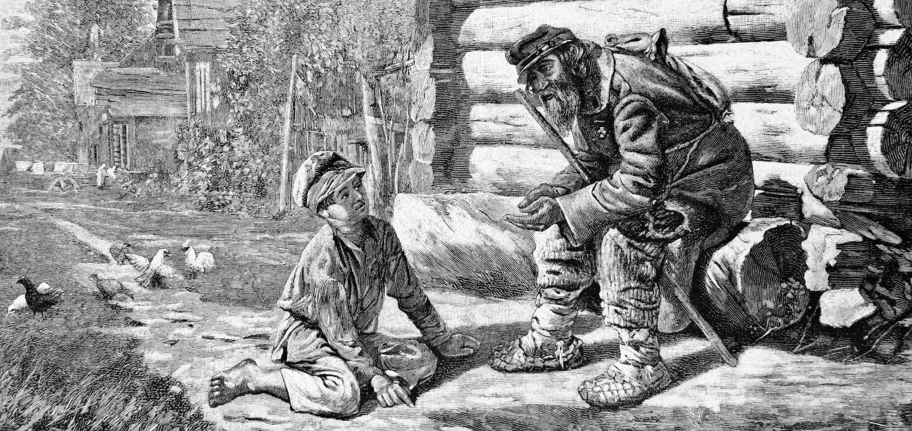An Ode to Souls in the Abyss
Is Judaism Law or Fire?
- October 11, 2017
- |
- 21 Tishrei 5778
Rabbi YY Jacobson
1928 views

An Ode to Souls in the Abyss
Is Judaism Law or Fire?
Rabbi YY Jacobson
- October 11, 2017
Fiery Law
In the opening of the portion of Vezos Habracah—the final portion of the Torah read on Simchas Torah—Moses describes the giving of the Torah to the Jewish people:[1]
He [Moses] said: "The Lord came from Sinai and shone forth from (the land of) Saeir to them; He appeared from Mt. Paran and came with some of the holy myriads; from His right hand He gave them a fiery Law.”
Here is how Moses, in his final moments on earth, described the nature of Torah: “Fiery law,” or in the original Hebrew, “Eish das.”
It is an extraordinary and profound description—the best definition for Judaism. “Fire” and “law” are opposites. Law is all about structure, order and rigid behavior, articulated by the law. That is the function of law: to uphold order in a society, to create boundaries which one may not cross.
Fire, in contrast, is the opposite of structure. It undermines, destroys and disintegrates any arrangement. It is never confined to one place, always swaying, moving, blazing, dancing, consuming something; it breaks down anything that enters into its realm. Try “telling” a fire to maintain order and to be respectful of boundaries, and it will consume you too. By its very nature, fires defy borders. Which is why fire represents unrestrained passion, zealotry, energy, which aspires to break out of the confined mode and strive for more, as a physical flame which is never content and seeks to consume more.
This is the heart of Judaism: it is both “aish” and “das,” fire and law, combined in one. The two seem paradoxical, but they are not. On the one hand, Judaism demands a life of precise structure and order. Every mitzvah and ritual has its time, place, and specific rules. Judaism demands consistency and stability, day in day out. It keeps us synchronized with the rhythm of time and the passage of seasons; it keeps us aligned with the transitions of light to darkness, and conversely, and to the patterns of the body and the universe. Halacha, Jewish law, is all about specific structure in minute details and specifications. As the countless intricate “laws” that govern the creation of a single cell, Torah governs the life of the Jew.
Yet together with that, Torah is “fire.” It challenges us to never stop growing, to open ourselves to the mystery and infinity of life, to transcend our habits and conventions, to re-invent ourselves, and to never stop burning; to continue to explore, grow and climb the mountains of infinity.
The laws of Torah are, in essence, tools to touch transcendence and infinity. The laws are not there to limit and contain, but rather to free up and express our full potential and glory. It’s like tying down the chords of the violin so that it can produce exquisite music.
The Old and the Young
This is how Torah has the power to attract both the young and the old. Usually the old folks are more comfortable with “law,” believing in consistency, order and stability. While the young are more comfortable with “fire,” with passion, idealism, breaking the mold and shaking up the status quo.
Systems that are based either on “law” (America of the 1950’s) or on “fire” (America of the 60’s), alienate one of the two demographics. Torah, in contrast, is “fiery law,” it is both law and fire, hence its power to capture the souls of the old and the young.
The Endless “Fiery” Quest
A story:
It was Simchat Torah, and the disciples of Rabbi Mendel of Horodok, many of whom had journeyed for weeks to spend the joyous festival with their Rebbe, were awaiting his entrance to the synagogue for the recital of the Atah Hor’eisa verses and the hakafot procession. Yet the Rebbe did not appear. Hours passed, and still Rabbi Mendel was secluded in his room.
Finally, they approached Rabbi Schneur Zalman of Liadi, who had studied with Rabbi Mendel in Mezeritch under the tutelage of the Great Maggid.[2] Perhaps Rabbi Schneur Zalman, who was revered and loved by Rabbi Mendel, would attempt what no other Chassid would dare: enter the Rebbe’s room and ask him to join his anxiously awaiting followers.
When Rabbi Schneur Zalman entered Rabbi Mendel’s study, he found the Chassidic master deeply engrossed in his thoughts. “The chassidim await you,” said Rabbi Schneur Zalman. “Why don’t you join them for the hakafot?”
“There are a hundred meanings to the verse Atah Hor’eisa,” cried Rabbi Mendel, “And I do not yet fully understand them all.[3] I cannot possibly come out to recite the verse without a proper comprehension of its significance!”
“Rebbe!” said Rabbi Schneur Zalman. “When you will reach a full comprehension of the hundred meanings of Atah Hor’eisa, you will discover another hundred meanings you have yet to comprehend...”
“You are right,” said Rabbi Mendel, rising from his seat. “Come, let us go to hakafot.”
Because Torah is not only law; it is also “fire.” Part of it must always remain elusive, challenging you to transcend yet again.
***
The “Arms” Below the Universe
There is a strange verse in the final portion of the Torah, read on Simchas Torah:[4]
מְעֹנָה אֱלֹקי קֶדֶם וּמִתַּחַת זְרֹעֹת עוֹלָם וַיְגָרֶשׁ מִפָּנֶיךָ אוֹיֵב וַיֹּאמֶר הַשְׁמֵד.
“[The Heavens] Are the abode for the G-d Who precedes all, and below the world are arms. He expelled the enemy from before you, and said, 'Destroy!'”
What is the meaning of this enigmatic statement that “below the world there are arms”?[5]
Rabbi Nachman of Breslov offered the following moving interpretation.
If we had to categorize all of humanity into two groups we could say that there are the people who are comfortable in the world; and there are people who find no place for themselves in our universe. There are those who just have their two feet etched confidentially on the ground. They know who they are and they know what they want, or even if not, they are not bothered by these questions.
But there are others who struggle with deep psychological, emotional, and spiritual dilemmas; people who experience deep anxiety, pain and grief; individuals who suffer from addiction, voids, and other internal maladies. All these people never feel fully present in our world; they never feel grounded and stationed solidly on the earth. Psychologically speaking they feel like they are falling off the ball of the planet.
It is to these people who Moses speaks and says: “Metachas zeroos olam,” below the world there are arms. When you feel like you are “falling off” the planet, that you have no place in our world, that you don’t belong here, you should know that below the world there are arms that will embrace you when you fall. These are the Divine “arms” in whom you can fall right into and allow them to contain all your pain and trauma.
But here is the catch: Only those who “fall off” the face of the earth can experience this embrace. As long as you feel secure in your own being, as long as you feel confident in your own ego, you can’t feel the transcendent embrace of G-d. Only when you have nothing else to hold on to, can you experience those loving arms which are always present below the world for those who are about to fall into the abyss.
Many of us have lots of pain and challenges in our lives. We often feel like we are “falling off” the planet, with no real light at the end of the tunnel. Allow yourself to land in G-d’s arms wrapped around the universe. Allow G-d to hug you.
A Shaky Hotel
The following story was told by the Rabbi Zalman Gurari, who witnessed the moment, to my late father, Gershon Jacobson:
One year, around 1933, a hotel was rented in Warsaw for the sixth Lubavitcher Rebbe, Rabbi Yosef Yitzchak Schnerson (1880-1950) to spend there the last days of Sukkot with his hundreds of disciples and followers, in prayer, study and celebration.
It was Simchat Torah during the hakafot. And as is the tradition in Chabad, the dancing was fierce. Hundreds of Chassidim were dancing with all their might, their soul, their heart, as their feet were jumping up and down in the heavenly symphony of Simchat Torah with the Lubavitcher Rebbe.
The owner of the hotel was a Rodomsker Chassid, a follower of the Chassidic dynasty of Rodomsk (which was almost completely wiped out in the Holocaust.) He ran over to the Lubavitcher Rebbe and exclaimed: I know the structure of this hotel, and it is not capable of holding up all this pressure, all this jumping and dancing. I am frightened that the building will cave in on us and the results can be catastrophic. You must tell the Chasidim to stop dancing at once!
The Rebbe, Rabbi Yosef Yitzchak Schneerson, smiled and said to him:
The Torah states “Metachas zeroos olam,” below the world there are arms. The Kabbalah explains this as referring to “zeroos d’Adam Kadmon,” the Divine arms which hold up the entire universe and the entire planet. Our planet, the earth, is suspended in mid-space. Who holds it up? G-d’s “arms!”
So, my dear Jew, the same “arms” holding up the entire planet, will hold up this hotel too!
The Chassidim continues to dance, jump and celebrate, till the wee hours of the morning. The hotel remained intact. But the greatest miracle, said Reb Zalman, was that this non-Chabad Chassid returned to his previous position calm and serene, with full trust in the words of the Rebbe.
[1] Deuteronomy 33:2
[2] Rabbi Menachem Mendel of Horodok (also called Rabbi Menachem Mendel of Vitebsk) and Rabbi Schneur Zalman of Liadi were both disciples of the Great Maggid, Rabbi DovBer of Mezeritch, the second leader of the Chassidic movement. Following the Maggid’s passing in 1772, Rabbi Schneur Zalman regarded Rabbi Mendel as his master and mentor. In 1777, Rabbi Mendel led a group of more than 300 chassidim to settle in the Holy Land. Rabbi Schneur Zalman was originally part of the group, but Rabbi Mendel convinced him to remain behind and assume the leadership of the chassidic community in White Russia and Lithuania.
[3] Atah Horeisa (“You have been shown...”) is the first of an anthology of seventeen verses recited as an introduction to the hakafot (joyous procession and dance with the Torah scrolls around the reading table) of Simchat Torah. The verse (Deuteronomy 4:35) reads: “You have been shown to know that Havayeh is Elokim, there is none else beside Him.” Chassidic teaching contains dozens of discourses and thousands of pages explaining the concepts contained in this verse.
[4] Ibid. 33:27
[5] Rashi translates zeroos as “the mighty ones,” that below are the mighty ones of the world. The translation here, based on the Chassidic masters, follows the literal meaning of zeroos as arms.
- Comment
Class Summary:
Is Judaism Law or Fire?
Dedicated by Eliyahu Bari in honor of his Eishet Chayil, Orna bas Chanah Bari
For blessings and success in all, materially and spiritually
Fiery Law
In the opening of the portion of Vezos Habracah—the final portion of the Torah read on Simchas Torah—Moses describes the giving of the Torah to the Jewish people:[1]
He [Moses] said: "The Lord came from Sinai and shone forth from (the land of) Saeir to them; He appeared from Mt. Paran and came with some of the holy myriads; from His right hand He gave them a fiery Law.”
Here is how Moses, in his final moments on earth, described the nature of Torah: “Fiery law,” or in the original Hebrew, “Eish das.”
It is an extraordinary and profound description—the best definition for Judaism. “Fire” and “law” are opposites. Law is all about structure, order and rigid behavior, articulated by the law. That is the function of law: to uphold order in a society, to create boundaries which one may not cross.
Fire, in contrast, is the opposite of structure. It undermines, destroys and disintegrates any arrangement. It is never confined to one place, always swaying, moving, blazing, dancing, consuming something; it breaks down anything that enters into its realm. Try “telling” a fire to maintain order and to be respectful of boundaries, and it will consume you too. By its very nature, fires defy borders. Which is why fire represents unrestrained passion, zealotry, energy, which aspires to break out of the confined mode and strive for more, as a physical flame which is never content and seeks to consume more.
This is the heart of Judaism: it is both “aish” and “das,” fire and law, combined in one. The two seem paradoxical, but they are not. On the one hand, Judaism demands a life of precise structure and order. Every mitzvah and ritual has its time, place, and specific rules. Judaism demands consistency and stability, day in day out. It keeps us synchronized with the rhythm of time and the passage of seasons; it keeps us aligned with the transitions of light to darkness, and conversely, and to the patterns of the body and the universe. Halacha, Jewish law, is all about specific structure in minute details and specifications. As the countless intricate “laws” that govern the creation of a single cell, Torah governs the life of the Jew.
Yet together with that, Torah is “fire.” It challenges us to never stop growing, to open ourselves to the mystery and infinity of life, to transcend our habits and conventions, to re-invent ourselves, and to never stop burning; to continue to explore, grow and climb the mountains of infinity.
The laws of Torah are, in essence, tools to touch transcendence and infinity. The laws are not there to limit and contain, but rather to free up and express our full potential and glory. It’s like tying down the chords of the violin so that it can produce exquisite music.
The Old and the Young
This is how Torah has the power to attract both the young and the old. Usually the old folks are more comfortable with “law,” believing in consistency, order and stability. While the young are more comfortable with “fire,” with passion, idealism, breaking the mold and shaking up the status quo.
Systems that are based either on “law” (America of the 1950’s) or on “fire” (America of the 60’s), alienate one of the two demographics. Torah, in contrast, is “fiery law,” it is both law and fire, hence its power to capture the souls of the old and the young.
The Endless “Fiery” Quest
A story:
It was Simchat Torah, and the disciples of Rabbi Mendel of Horodok, many of whom had journeyed for weeks to spend the joyous festival with their Rebbe, were awaiting his entrance to the synagogue for the recital of the Atah Hor’eisa verses and the hakafot procession. Yet the Rebbe did not appear. Hours passed, and still Rabbi Mendel was secluded in his room.
Finally, they approached Rabbi Schneur Zalman of Liadi, who had studied with Rabbi Mendel in Mezeritch under the tutelage of the Great Maggid.[2] Perhaps Rabbi Schneur Zalman, who was revered and loved by Rabbi Mendel, would attempt what no other Chassid would dare: enter the Rebbe’s room and ask him to join his anxiously awaiting followers.
When Rabbi Schneur Zalman entered Rabbi Mendel’s study, he found the Chassidic master deeply engrossed in his thoughts. “The chassidim await you,” said Rabbi Schneur Zalman. “Why don’t you join them for the hakafot?”
“There are a hundred meanings to the verse Atah Hor’eisa,” cried Rabbi Mendel, “And I do not yet fully understand them all.[3] I cannot possibly come out to recite the verse without a proper comprehension of its significance!”
“Rebbe!” said Rabbi Schneur Zalman. “When you will reach a full comprehension of the hundred meanings of Atah Hor’eisa, you will discover another hundred meanings you have yet to comprehend...”
“You are right,” said Rabbi Mendel, rising from his seat. “Come, let us go to hakafot.”
Because Torah is not only law; it is also “fire.” Part of it must always remain elusive, challenging you to transcend yet again.
***
The “Arms” Below the Universe
There is a strange verse in the final portion of the Torah, read on Simchas Torah:[4]
מְעֹנָה אֱלֹקי קֶדֶם וּמִתַּחַת זְרֹעֹת עוֹלָם וַיְגָרֶשׁ מִפָּנֶיךָ אוֹיֵב וַיֹּאמֶר הַשְׁמֵד.
“[The Heavens] Are the abode for the G-d Who precedes all, and below the world are arms. He expelled the enemy from before you, and said, 'Destroy!'”
What is the meaning of this enigmatic statement that “below the world there are arms”?[5]
Rabbi Nachman of Breslov offered the following moving interpretation.
If we had to categorize all of humanity into two groups we could say that there are the people who are comfortable in the world; and there are people who find no place for themselves in our universe. There are those who just have their two feet etched confidentially on the ground. They know who they are and they know what they want, or even if not, they are not bothered by these questions.
But there are others who struggle with deep psychological, emotional, and spiritual dilemmas; people who experience deep anxiety, pain and grief; individuals who suffer from addiction, voids, and other internal maladies. All these people never feel fully present in our world; they never feel grounded and stationed solidly on the earth. Psychologically speaking they feel like they are falling off the ball of the planet.
It is to these people who Moses speaks and says: “Metachas zeroos olam,” below the world there are arms. When you feel like you are “falling off” the planet, that you have no place in our world, that you don’t belong here, you should know that below the world there are arms that will embrace you when you fall. These are the Divine “arms” in whom you can fall right into and allow them to contain all your pain and trauma.
But here is the catch: Only those who “fall off” the face of the earth can experience this embrace. As long as you feel secure in your own being, as long as you feel confident in your own ego, you can’t feel the transcendent embrace of G-d. Only when you have nothing else to hold on to, can you experience those loving arms which are always present below the world for those who are about to fall into the abyss.
Many of us have lots of pain and challenges in our lives. We often feel like we are “falling off” the planet, with no real light at the end of the tunnel. Allow yourself to land in G-d’s arms wrapped around the universe. Allow G-d to hug you.
A Shaky Hotel
The following story was told by the Rabbi Zalman Gurari, who witnessed the moment, to my late father, Gershon Jacobson:
One year, around 1933, a hotel was rented in Warsaw for the sixth Lubavitcher Rebbe, Rabbi Yosef Yitzchak Schnerson (1880-1950) to spend there the last days of Sukkot with his hundreds of disciples and followers, in prayer, study and celebration.
It was Simchat Torah during the hakafot. And as is the tradition in Chabad, the dancing was fierce. Hundreds of Chassidim were dancing with all their might, their soul, their heart, as their feet were jumping up and down in the heavenly symphony of Simchat Torah with the Lubavitcher Rebbe.
The owner of the hotel was a Rodomsker Chassid, a follower of the Chassidic dynasty of Rodomsk (which was almost completely wiped out in the Holocaust.) He ran over to the Lubavitcher Rebbe and exclaimed: I know the structure of this hotel, and it is not capable of holding up all this pressure, all this jumping and dancing. I am frightened that the building will cave in on us and the results can be catastrophic. You must tell the Chasidim to stop dancing at once!
The Rebbe, Rabbi Yosef Yitzchak Schneerson, smiled and said to him:
The Torah states “Metachas zeroos olam,” below the world there are arms. The Kabbalah explains this as referring to “zeroos d’Adam Kadmon,” the Divine arms which hold up the entire universe and the entire planet. Our planet, the earth, is suspended in mid-space. Who holds it up? G-d’s “arms!”
So, my dear Jew, the same “arms” holding up the entire planet, will hold up this hotel too!
The Chassidim continues to dance, jump and celebrate, till the wee hours of the morning. The hotel remained intact. But the greatest miracle, said Reb Zalman, was that this non-Chabad Chassid returned to his previous position calm and serene, with full trust in the words of the Rebbe.
[1] Deuteronomy 33:2
[2] Rabbi Menachem Mendel of Horodok (also called Rabbi Menachem Mendel of Vitebsk) and Rabbi Schneur Zalman of Liadi were both disciples of the Great Maggid, Rabbi DovBer of Mezeritch, the second leader of the Chassidic movement. Following the Maggid’s passing in 1772, Rabbi Schneur Zalman regarded Rabbi Mendel as his master and mentor. In 1777, Rabbi Mendel led a group of more than 300 chassidim to settle in the Holy Land. Rabbi Schneur Zalman was originally part of the group, but Rabbi Mendel convinced him to remain behind and assume the leadership of the chassidic community in White Russia and Lithuania.
[3] Atah Horeisa (“You have been shown...”) is the first of an anthology of seventeen verses recited as an introduction to the hakafot (joyous procession and dance with the Torah scrolls around the reading table) of Simchat Torah. The verse (Deuteronomy 4:35) reads: “You have been shown to know that Havayeh is Elokim, there is none else beside Him.” Chassidic teaching contains dozens of discourses and thousands of pages explaining the concepts contained in this verse.
[4] Ibid. 33:27
[5] Rashi translates zeroos as “the mighty ones,” that below are the mighty ones of the world. The translation here, based on the Chassidic masters, follows the literal meaning of zeroos as arms.
Tags
Categories
Simchas Torah/Vezos Habracha Essay
Rabbi YY Jacobson
- October 11, 2017
- |
- 21 Tishrei 5778
- |
- 1928 views

An Ode to Souls in the Abyss
Is Judaism Law or Fire?
Rabbi YY Jacobson
- October 11, 2017
Fiery Law
In the opening of the portion of Vezos Habracah—the final portion of the Torah read on Simchas Torah—Moses describes the giving of the Torah to the Jewish people:[1]
He [Moses] said: "The Lord came from Sinai and shone forth from (the land of) Saeir to them; He appeared from Mt. Paran and came with some of the holy myriads; from His right hand He gave them a fiery Law.”
Here is how Moses, in his final moments on earth, described the nature of Torah: “Fiery law,” or in the original Hebrew, “Eish das.”
It is an extraordinary and profound description—the best definition for Judaism. “Fire” and “law” are opposites. Law is all about structure, order and rigid behavior, articulated by the law. That is the function of law: to uphold order in a society, to create boundaries which one may not cross.
Fire, in contrast, is the opposite of structure. It undermines, destroys and disintegrates any arrangement. It is never confined to one place, always swaying, moving, blazing, dancing, consuming something; it breaks down anything that enters into its realm. Try “telling” a fire to maintain order and to be respectful of boundaries, and it will consume you too. By its very nature, fires defy borders. Which is why fire represents unrestrained passion, zealotry, energy, which aspires to break out of the confined mode and strive for more, as a physical flame which is never content and seeks to consume more.
This is the heart of Judaism: it is both “aish” and “das,” fire and law, combined in one. The two seem paradoxical, but they are not. On the one hand, Judaism demands a life of precise structure and order. Every mitzvah and ritual has its time, place, and specific rules. Judaism demands consistency and stability, day in day out. It keeps us synchronized with the rhythm of time and the passage of seasons; it keeps us aligned with the transitions of light to darkness, and conversely, and to the patterns of the body and the universe. Halacha, Jewish law, is all about specific structure in minute details and specifications. As the countless intricate “laws” that govern the creation of a single cell, Torah governs the life of the Jew.
Yet together with that, Torah is “fire.” It challenges us to never stop growing, to open ourselves to the mystery and infinity of life, to transcend our habits and conventions, to re-invent ourselves, and to never stop burning; to continue to explore, grow and climb the mountains of infinity.
The laws of Torah are, in essence, tools to touch transcendence and infinity. The laws are not there to limit and contain, but rather to free up and express our full potential and glory. It’s like tying down the chords of the violin so that it can produce exquisite music.
The Old and the Young
This is how Torah has the power to attract both the young and the old. Usually the old folks are more comfortable with “law,” believing in consistency, order and stability. While the young are more comfortable with “fire,” with passion, idealism, breaking the mold and shaking up the status quo.
Systems that are based either on “law” (America of the 1950’s) or on “fire” (America of the 60’s), alienate one of the two demographics. Torah, in contrast, is “fiery law,” it is both law and fire, hence its power to capture the souls of the old and the young.
The Endless “Fiery” Quest
A story:
It was Simchat Torah, and the disciples of Rabbi Mendel of Horodok, many of whom had journeyed for weeks to spend the joyous festival with their Rebbe, were awaiting his entrance to the synagogue for the recital of the Atah Hor’eisa verses and the hakafot procession. Yet the Rebbe did not appear. Hours passed, and still Rabbi Mendel was secluded in his room.
Finally, they approached Rabbi Schneur Zalman of Liadi, who had studied with Rabbi Mendel in Mezeritch under the tutelage of the Great Maggid.[2] Perhaps Rabbi Schneur Zalman, who was revered and loved by Rabbi Mendel, would attempt what no other Chassid would dare: enter the Rebbe’s room and ask him to join his anxiously awaiting followers.
When Rabbi Schneur Zalman entered Rabbi Mendel’s study, he found the Chassidic master deeply engrossed in his thoughts. “The chassidim await you,” said Rabbi Schneur Zalman. “Why don’t you join them for the hakafot?”
“There are a hundred meanings to the verse Atah Hor’eisa,” cried Rabbi Mendel, “And I do not yet fully understand them all.[3] I cannot possibly come out to recite the verse without a proper comprehension of its significance!”
“Rebbe!” said Rabbi Schneur Zalman. “When you will reach a full comprehension of the hundred meanings of Atah Hor’eisa, you will discover another hundred meanings you have yet to comprehend...”
“You are right,” said Rabbi Mendel, rising from his seat. “Come, let us go to hakafot.”
Because Torah is not only law; it is also “fire.” Part of it must always remain elusive, challenging you to transcend yet again.
***
The “Arms” Below the Universe
There is a strange verse in the final portion of the Torah, read on Simchas Torah:[4]
מְעֹנָה אֱלֹקי קֶדֶם וּמִתַּחַת זְרֹעֹת עוֹלָם וַיְגָרֶשׁ מִפָּנֶיךָ אוֹיֵב וַיֹּאמֶר הַשְׁמֵד.
“[The Heavens] Are the abode for the G-d Who precedes all, and below the world are arms. He expelled the enemy from before you, and said, 'Destroy!'”
What is the meaning of this enigmatic statement that “below the world there are arms”?[5]
Rabbi Nachman of Breslov offered the following moving interpretation.
If we had to categorize all of humanity into two groups we could say that there are the people who are comfortable in the world; and there are people who find no place for themselves in our universe. There are those who just have their two feet etched confidentially on the ground. They know who they are and they know what they want, or even if not, they are not bothered by these questions.
But there are others who struggle with deep psychological, emotional, and spiritual dilemmas; people who experience deep anxiety, pain and grief; individuals who suffer from addiction, voids, and other internal maladies. All these people never feel fully present in our world; they never feel grounded and stationed solidly on the earth. Psychologically speaking they feel like they are falling off the ball of the planet.
It is to these people who Moses speaks and says: “Metachas zeroos olam,” below the world there are arms. When you feel like you are “falling off” the planet, that you have no place in our world, that you don’t belong here, you should know that below the world there are arms that will embrace you when you fall. These are the Divine “arms” in whom you can fall right into and allow them to contain all your pain and trauma.
But here is the catch: Only those who “fall off” the face of the earth can experience this embrace. As long as you feel secure in your own being, as long as you feel confident in your own ego, you can’t feel the transcendent embrace of G-d. Only when you have nothing else to hold on to, can you experience those loving arms which are always present below the world for those who are about to fall into the abyss.
Many of us have lots of pain and challenges in our lives. We often feel like we are “falling off” the planet, with no real light at the end of the tunnel. Allow yourself to land in G-d’s arms wrapped around the universe. Allow G-d to hug you.
A Shaky Hotel
The following story was told by the Rabbi Zalman Gurari, who witnessed the moment, to my late father, Gershon Jacobson:
One year, around 1933, a hotel was rented in Warsaw for the sixth Lubavitcher Rebbe, Rabbi Yosef Yitzchak Schnerson (1880-1950) to spend there the last days of Sukkot with his hundreds of disciples and followers, in prayer, study and celebration.
It was Simchat Torah during the hakafot. And as is the tradition in Chabad, the dancing was fierce. Hundreds of Chassidim were dancing with all their might, their soul, their heart, as their feet were jumping up and down in the heavenly symphony of Simchat Torah with the Lubavitcher Rebbe.
The owner of the hotel was a Rodomsker Chassid, a follower of the Chassidic dynasty of Rodomsk (which was almost completely wiped out in the Holocaust.) He ran over to the Lubavitcher Rebbe and exclaimed: I know the structure of this hotel, and it is not capable of holding up all this pressure, all this jumping and dancing. I am frightened that the building will cave in on us and the results can be catastrophic. You must tell the Chasidim to stop dancing at once!
The Rebbe, Rabbi Yosef Yitzchak Schneerson, smiled and said to him:
The Torah states “Metachas zeroos olam,” below the world there are arms. The Kabbalah explains this as referring to “zeroos d’Adam Kadmon,” the Divine arms which hold up the entire universe and the entire planet. Our planet, the earth, is suspended in mid-space. Who holds it up? G-d’s “arms!”
So, my dear Jew, the same “arms” holding up the entire planet, will hold up this hotel too!
The Chassidim continues to dance, jump and celebrate, till the wee hours of the morning. The hotel remained intact. But the greatest miracle, said Reb Zalman, was that this non-Chabad Chassid returned to his previous position calm and serene, with full trust in the words of the Rebbe.
[1] Deuteronomy 33:2
[2] Rabbi Menachem Mendel of Horodok (also called Rabbi Menachem Mendel of Vitebsk) and Rabbi Schneur Zalman of Liadi were both disciples of the Great Maggid, Rabbi DovBer of Mezeritch, the second leader of the Chassidic movement. Following the Maggid’s passing in 1772, Rabbi Schneur Zalman regarded Rabbi Mendel as his master and mentor. In 1777, Rabbi Mendel led a group of more than 300 chassidim to settle in the Holy Land. Rabbi Schneur Zalman was originally part of the group, but Rabbi Mendel convinced him to remain behind and assume the leadership of the chassidic community in White Russia and Lithuania.
[3] Atah Horeisa (“You have been shown...”) is the first of an anthology of seventeen verses recited as an introduction to the hakafot (joyous procession and dance with the Torah scrolls around the reading table) of Simchat Torah. The verse (Deuteronomy 4:35) reads: “You have been shown to know that Havayeh is Elokim, there is none else beside Him.” Chassidic teaching contains dozens of discourses and thousands of pages explaining the concepts contained in this verse.
[4] Ibid. 33:27
[5] Rashi translates zeroos as “the mighty ones,” that below are the mighty ones of the world. The translation here, based on the Chassidic masters, follows the literal meaning of zeroos as arms.
- Comment
Dedicated by Eliyahu Bari in honor of his Eishet Chayil, Orna bas Chanah Bari
For blessings and success in all, materially and spiritually
Class Summary:
Is Judaism Law or Fire?
Related Classes
Please help us continue our work
Sign up to receive latest content by Rabbi YY
Join our WhatsApp Community
Join our WhatsApp Community










Please leave your comment below!
Yehudah -7 years ago
An Ode to those in the Abyss
Reply to this comment.Flag this comment.
Sara -7 years ago
The “Arms” Below the Universe and Shaky Hotel
I love these from the article... "
The Arms Below the Universe piece
. "You should know that below the world there are arms that will embrace you when you fall" - I looked at the footnotes and I think you are saying that zooros is defined as arms per the Chasidic Masters. That the literal meaning of zooros (zoorot) is arms. It is a kabbalistic concept? Can you tell me more?
Shaky Hotel piece
. "Our planet the Earth is suspended in mid space. Who holds it up? G_D's arms." ... Rabbi Yosef Yitzhak Shneerson
Thanks,
Sara
Reply to this comment.Flag this comment.